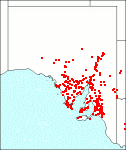Family: Asteraceae
Millotia myosotidifolia
Citation:
Steetz in Lehm., Pl. Preiss. 1:457 (1845).
Synonymy: Senecio myosotidifolius Benth. in Endl., Enum. Pl. Hügel 1:66 (1837); M. glabra Steetz in Lehm., Pl. Preiss. 1:458 (1845); M. robusta Steetz in Lehm., Pl. Preiss. 1:458 (1845); M. depauperata Stapf, Kew Bull. 1910:22 (1910); M. tenuifolia sensu J. Black, Fl. S. Aust. 917 (1957), partly, non Cass.
Common name: Broad-leaved millolia.
Description:
Spreading annual herb to 20 cm high; glandular hairs absent; stems ascending or erect, thickened at the base, branched, densely to very sparsely grey-woolly; leaves narrowly oblanceolate to oblanceolate, sometimes somewhat spathulate, 1-5 cm long, up to 6 mm wide, amplexicaul, minutely apiculate, sparsely to densely grey-cobwebby.
Peduncles to 10 cm long, distinct, leafless or with 1 or 2 reduced linear leaves; involucre 4-8 mm long; bracts 6-15, overlapping and appearing 2-seriate, oblong, with narrowly linear cobwebby midribs and wider scarious stramineous or purplish margins; bract apices entire, apiculate; florets c. 15-45, 5-merous; corolla white, rarely cream; tube 3-6 mm long, deflexed in the outer florets, becoming reddish-brown; lobes acute to acuminate, 0.5-0.8 mm long; anther cells 0.8-1.3 mm long.
Achene linear to broadly linear, 4-8 mm long, scabridulous, brown, with a distinct flattened paler beak 1-4 mm long; pappus of 15-25 barbellate bristles, subplumose near the tips, almost as long as the corolla, rarely reduced.
Published illustration:
Cunningham et al. (1982) Plants of western New South Wales, p. 705.
|
|
Distribution:
|
In woodland, mallee, mulga and shrubland communities, mainly on sandy soils.
S.Aust.: FR, EP, NL, MU, YP, SL, KI, SE. W.Aust.; N.S.W.; Vic.; Tas.
|
Conservation status:
native
Flowering time: July — Nov.
|

SA Distribution Map based
on current data relating to
specimens held in the
State Herbarium of South Australia
|
Biology:
M. myosotidifolia has a high tolerance of copper, which it accumulates, and often occurs in dense colonies around old copper mines.
Author:
Not yet available
|

